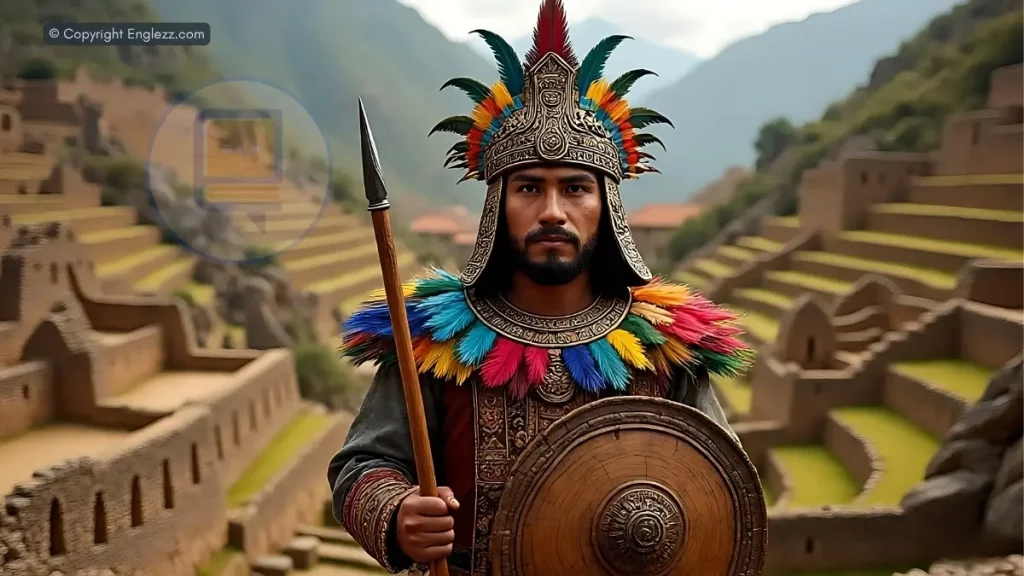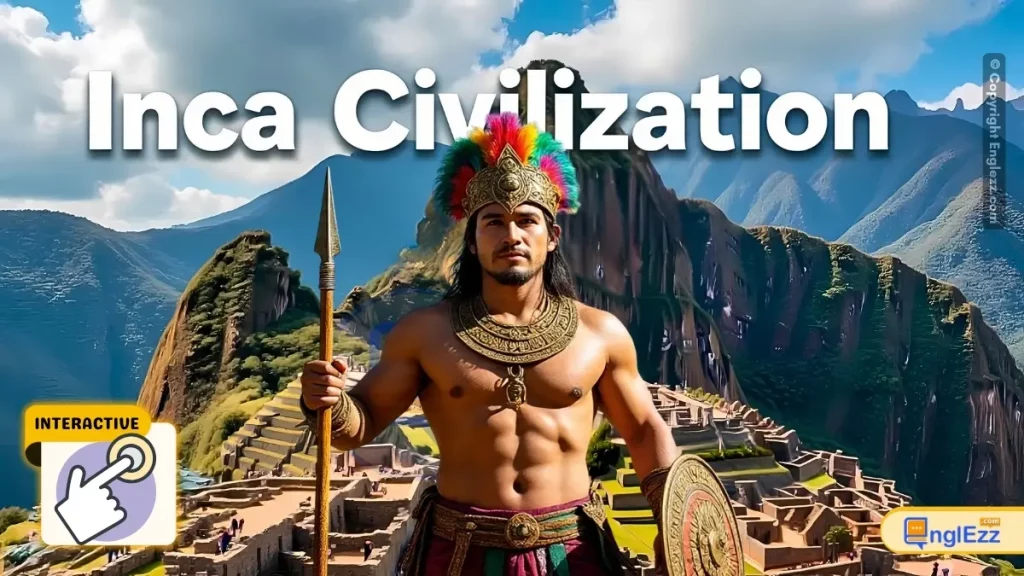
The Story of the Inca Empire
Inca (1438-1533 CE) – Machu Picchu, vast road system
Introduction
The Inca Journey
The Inca Empire was the largest empire in pre-Columbian America, stretching along the Andes mountains from modern-day Colombia to Chile. At its height, it ruled over 12 million people and featured remarkable achievements in architecture, engineering, and administration without the use of a writing system.
The Inca excelled at stone masonry, road construction, terrace farming, and textile production. Their vast road system (Qhapaq Ñan) spanned over 40,000 km, connecting their empire. The famous site of Machu Picchu stands as a testament to their architectural genius, built without mortar yet surviving earthquakes for centuries.
Early Inca Period
The Inca began as a small tribe in the Cusco region around 1200 CE. Under leaders like Manco Cápac, they established their capital at Cusco. During this formative period, they developed their distinctive architectural style and began expanding their influence through alliances and limited conquests in the surrounding valleys.
Imperial Expansion
From 1438 under Pachacuti and his successors, the Inca expanded rapidly to create the largest empire in the Americas. They developed sophisticated administrative systems, built extensive road networks, and implemented innovative agricultural techniques like terrace farming. The empire was organized into four quarters (Tawantinsuyu) with Cusco at its center.
Modern Rediscovery
After centuries of obscurity following the Spanish conquest, the Inca civilization was rediscovered in the 20th century. Hiram Bingham’s 1911 expedition brought Machu Picchu to world attention. Today, millions visit Inca sites annually, and Quechua-speaking descendants maintain many cultural traditions across the Andes.
Interactive Inca Empire Timeline
Legendary Founding of Cusco
According to Inca legend, Manco Cápac and Mama Ocllo emerge from Lake Titicaca to found Cusco, establishing the Inca civilization.
Read moreThe Inca origin story tells of the sun god Inti sending his children Manco Cápac and Mama Ocllo to bring civilization to the world. They emerged from the waters of Lake Titicaca carrying a golden staff, which sank into the ground at the site where they would establish Cusco, the “navel of the world.”
Archaeological evidence suggests the Inca were originally a small pastoral tribe in the Cusco region during this period. They gradually developed their distinctive culture, including:
- Polytheistic religion centered on Inti (sun god) and Viracocha (creator god)
- Advanced stone masonry techniques
- Agricultural innovations like terrace farming
- Early forms of the quipu recording system
This foundational period established the cultural and political traditions that would later enable the Inca’s rapid expansion.
Further Reading
- Bauer, Brian S. The Development of the Inca State (1992)
- Urton, Gary. Inca Myths (1999)
Early Expansion Under Inca Roca
Inca Roca begins expanding Inca influence beyond the Cusco valley, establishing early administrative systems.
Read moreInca Roca, the sixth Sapa Inca, initiated the first significant expansion beyond the immediate Cusco valley. His reign marked the transition from a local chiefdom to a regional power through both military conquest and diplomatic alliances.
Key developments during this period included:
- Construction of the first royal palace in Cusco
- Establishment of the yanacona system (permanent servants)
- Early development of the mit’a labor system
- Expansion of irrigation systems and agricultural terraces
Inca Roca also established the Hurin (lower) and Hanan (upper) division of Cusco, a dual organization that would characterize Inca administration. This period laid the groundwork for the imperial expansion that would follow under later rulers.
Further Reading
- Rowe, John H. Inca Culture at the Time of the Spanish Conquest (1946)
- Julien, Catherine J. Reading Inca History (2000)
Pachacuti’s Rise and Imperial Expansion
Pachacuti Inca Yupanqui becomes Sapa Inca after defending Cusco from the Chanka and begins transforming the Inca state into an empire.
Read morePachacuti (“Earth Shaker”) came to power after a dramatic victory over the invading Chanka people. According to legend, he transformed stones into warriors to help defeat the enemy. This marked the beginning of the Inca Empire’s rapid expansion.
Pachacuti’s revolutionary changes included:
- Reorganization of Cusco into the shape of a puma
- Construction of monumental architecture including Sacsayhuamán
- Creation of the mit’a system for labor organization
- Implementation of a standardized administrative system
- Expansion of the road network that would become the Qhapaq Ñan
Under Pachacuti, the Inca expanded north to Quito and south to Lake Titicaca, establishing the foundations of Tawantinsuyu, the “Land of the Four Quarters.”
Further Reading
- Brundage, Burr Cartwright. Empire of the Inca (1963)
- D’Altroy, Terence N. The Incas (2002)
Construction of Machu Picchu Begins
Pachacuti orders construction of the royal estate at Machu Picchu, showcasing Inca architectural mastery.
Read moreMachu Picchu was built as a royal estate for Pachacuti, situated dramatically on a mountain ridge above the Urubamba River. The site exemplifies Inca engineering and architectural genius:
- Precision stonework without mortar that has withstood earthquakes
- Sophisticated water management with 16 fountains and irrigation
- Terraced agriculture that prevented erosion
- Astronomical alignments in temple construction
- Integration with the sacred landscape
The site was likely used for ceremonial purposes and as a retreat for the elite. Its remote location and careful construction made it one of the best-preserved Inca sites, hidden from Spanish conquistadors and only rediscovered in 1911.
Further Reading
- Wright, Kenneth R., and Alfredo Valencia Zegarra. Machu Picchu: A Civil Engineering Marvel (2000)
- Reinhard, Johan. Machu Picchu: Exploring an Ancient Sacred Center (2007)
Tupac Inca Yupanqui Expands the Empire
Pachacuti’s son Tupac Inca Yupanqui becomes Sapa Inca and greatly expands the empire north into Ecuador and south into Chile.
Read moreTupac Inca Yupanqui continued his father’s imperial expansion, making the Inca Empire the largest in pre-Columbian America. His military campaigns and diplomatic efforts extended Inca control over diverse regions and peoples.
Key achievements during his reign included:
- Conquest of the Chimú civilization in northern Peru
- Expansion into modern-day Ecuador and Chile
- Construction of monumental architecture including Ollantaytambo
- Further development of the road system and tambos (waystations)
- Implementation of the mitmaq system (population resettlement)
Tupac Inca also reportedly led an oceanic expedition that may have reached Polynesia, according to some interpretations of Inca oral histories recorded by Spanish chroniclers.
Further Reading
- Rostworowski de Diez Canseco, María. History of the Inca Realm (1999)
- Hemming, John. The Conquest of the Incas (1970)
Huayna Capac’s Reign and Civil War
Huayna Capac becomes Sapa Inca, expands the empire to its greatest extent, but his death leads to civil war between his sons.
Huayna Capac ruled during the empire’s peak, expanding north into Colombia and consolidating control over the vast territories conquered by his predecessors. He established Quito as a secondary capital and spent much of his reign there.
Key developments during his rule:
- Further expansion of the road network and administrative centers
- Construction of monumental architecture including Ingapirca in Ecuador
- Increased use of the mitmaq system to integrate conquered peoples
- Development of the quipu recording system for administration
Huayna Capac’s death around 1527 (possibly from European diseases arriving before the Spanish themselves) triggered a devastating civil war between his sons Huáscar and Atahualpa, weakening the empire just before the Spanish arrival.
Further Reading
- D’Altroy, Terence N. The Incas (2002)
- Pärssinen, Martti. Tawantinsuyu: The Inca State and Its Political Organization (1992)
Capture of Atahualpa
Francisco Pizarro captures Atahualpa at Cajamarca, marking the beginning of the Spanish conquest of the Inca Empire.
Read moreTaking advantage of the Inca civil war and the empire’s weakened state, Francisco Pizarro and his small band of conquistadors captured Atahualpa after massacring thousands of his retinue in the plaza of Cajamarca. This marked the beginning of the end for the Inca Empire.
Key aspects of this pivotal event:
- Atahualpa offered a room filled with gold and silver as ransom
- Despite the ransom payment, the Spanish executed Atahualpa in 1533
- The Spanish installed puppet rulers (Manco Inca initially)
- European diseases devastated the Inca population
- The Spanish looted vast quantities of gold and silver artifacts
The capture demonstrated how Spanish technological advantages (steel weapons, horses, and firearms) combined with perfect timing during the empire’s political instability enabled a small force to conquer a vast empire.
Further Reading
- Hemming, John. The Conquest of the Incas (1970)
- Prescott, William H. History of the Conquest of Peru (1847)
Fall of the Neo-Inca State
The Spanish execute Túpac Amaru, the last Inca ruler of Vilcabamba, marking the final end of Inca resistance.
Read moreAfter the Spanish captured Cusco in 1533, Manco Inca initially cooperated but later led a rebellion, establishing a Neo-Inca state at Vilcabamba in the remote jungle. This rump state maintained Inca traditions and resisted Spanish rule for nearly 40 years.
Key events in the Neo-Inca state’s resistance:
- Manco Inca’s siege of Cusco in 1536 nearly succeeded
- The Spanish founded Lima as their new capital in 1535
- Vilcabamba served as a refuge for Inca nobility and traditions
- The Spanish finally conquered Vilcabamba in 1572
- Túpac Amaru was captured and executed in Cusco’s main square
Túpac Amaru’s execution marked the formal end of the Inca dynasty, though rebellions invoking the Inca name would continue for centuries. The Spanish systematically destroyed Inca religious sites and suppressed indigenous traditions while exploiting the population through the encomienda system.
Further Reading
- Hemming, John. The Conquest of the Incas (1970)
- Bauer, Brian S. Ancient Cuzco: Heartland of the Inca (2004)
Rediscovery of Machu Picchu
Hiram Bingham’s expedition brings Machu Picchu to world attention, though local people had always known of its existence.
Read moreWhile searching for the lost city of Vilcabamba, Yale professor Hiram Bingham was led to Machu Picchu by local Quechua people. His subsequent publications and National Geographic coverage made the site internationally famous.
Key aspects of the rediscovery:
- Bingham initially believed he had found Vilcabamba
- The site was remarkably well-preserved, having been abandoned but not destroyed
- Bingham removed thousands of artifacts to Yale (later repatriated)
- The discovery sparked worldwide interest in Inca civilization
- Machu Picchu became Peru’s most famous tourist attraction
While Bingham popularized Machu Picchu, recent research shows that missionaries and explorers had visited the site earlier, and local farmers were living among the ruins when Bingham arrived. The site’s true purpose remains debated among scholars.
Further Reading
- Bingham, Hiram. Lost City of the Incas (1948)
- Salazar, Lucy C. Machu Picchu: Unveiling the Mystery of the Incas (2004)
Machu Picchu Declared UNESCO World Heritage Site
UNESCO designates Machu Picchu as a World Heritage Site, recognizing its cultural and historical significance.
Read moreThe UNESCO designation recognized Machu Picchu as both a cultural and natural wonder, protecting the site and its surrounding environment. It has since become one of the most iconic archaeological sites in the world.
Key aspects of Machu Picchu’s preservation:
- The site receives over 1 million visitors annually
- Conservation efforts balance tourism with preservation
- New visitor regulations were implemented to prevent damage
- The surrounding landscape is protected as a Historic Sanctuary
- Ongoing archaeological research continues to reveal new insights
In 2007, Machu Picchu was voted one of the New Seven Wonders of the World in a global poll. The site remains a powerful symbol of Inca achievement and South American cultural heritage.
Further Reading
- UNESCO World Heritage Centre. Historic Sanctuary of Machu Picchu (1983)
- Turner, Bethany L. Biological Anthropology of the Human Skeleton from Machu Picchu (2018)
Inca Empire Quiz
Test Your Knowledge of Inca History
Frequently Asked Questions
Common Questions About the Inca Empire
The Inca developed sophisticated stone-working techniques that allowed them to construct buildings without mortar:
- Precision cutting: Stones were carefully shaped to fit perfectly together
- Ashlar masonry: Stones were cut with slightly convex surfaces that locked together
- Earthquake resistance: The slight flexibility of dry-stone construction helped structures survive tremors
- Interlocking shapes: Some stones were cut with protrusions that fit into indentations in adjacent stones
- Labor-intensive process: Stones were shaped using harder stones and abrasives
This construction method, combined with careful foundation work and drainage systems, has allowed Inca structures to endure for centuries in an earthquake-prone region.
The Qhapaq Ñan (Royal Road) was one of the Inca Empire’s most impressive achievements:
- Length: Over 40,000 km (25,000 miles) of roads
- Coverage: Spanned the entire empire from Colombia to Chile
- Construction: Included paved stone paths, stairways, bridges, and tunnels
- Infrastructure: Featured tambos (waystations) every 20-30 km for rest and supplies
- Communication: Used by chasqui runners to relay messages quickly across the empire
The road system connected the empire administratively, militarily, and economically, allowing rapid movement of troops, goods, and information. In 2014, UNESCO recognized the Qhapaq Ñan as a World Heritage Site.
The Inca developed sophisticated agricultural techniques to grow crops in the Andes:
- Potatoes: Hundreds of varieties adapted to different altitudes
- Maize: Important for making chicha (ceremonial beer)
- Quinoa: Protein-rich grain that thrived at high altitudes
- Other crops: Oca, ulluco, mashua, beans, squash, peppers, coca
- Techniques: Terraces, irrigation, crop rotation, and freeze-drying (chuño)
The Inca’s agricultural innovations allowed them to support a large population in challenging mountainous terrain. Their terrace systems prevented erosion and created microclimates for different crops.
Yes, millions of people in the Andes are descendants of the Inca and maintain many cultural traditions:
- Quechua speakers: About 8-10 million people speak Quechua today
- Cultural practices: Traditional weaving, agriculture, and festivals continue
- Religion: Syncretism of Catholicism with traditional beliefs
- Communities: Many maintain ayllu (community) organization
- Political movements: Inca heritage is celebrated in indigenous rights movements
While the Spanish conquest devastated Inca society, many aspects of their culture survived and continue to influence Andean life today. The Quechua language, once the lingua franca of the empire, remains widely spoken.
Conclusion
The Inca Legacy
The Inca Empire represents one of the most remarkable civilizations in human history, achieving monumental architectural and engineering feats without the use of wheels, iron tools, or a formal writing system. In less than a century, they built the largest empire in the pre-Columbian Americas, with sophisticated administrative systems that integrated diverse peoples across challenging terrain.
While the Spanish conquest brought an abrupt end to the Inca state, their cultural legacy endures in the Andes through their descendants, language, agricultural practices, and architectural marvels that continue to inspire awe centuries later.
Inca Empire Key Takeaways
Early Foundations
The Inca began as a small tribe in the Cusco region, gradually developing their distinctive culture and administrative systems before their rapid imperial expansion.
Imperial Expansion
Under Pachacuti and his successors, the Inca expanded rapidly to create a vast empire unified by sophisticated road and administrative systems.
Engineering Marvels
The Inca built Machu Picchu, an extensive road network, and other architectural wonders using advanced techniques without mortar or modern tools.
Spanish Conquest
The empire fell to Spanish conquistadors who exploited internal divisions, but Inca resistance continued for decades in Vilcabamba.
Modern Rediscovery
Machu Picchu’s rediscovery brought worldwide attention to Inca achievements, while millions of their descendants preserve cultural traditions.
The study of the Inca Empire reveals how human ingenuity can create complex societies even in challenging environments. Their achievements in architecture, engineering, and administration without many technologies considered essential by other civilizations continue to fascinate scholars and inspire people worldwide.
Recommended Reading About the Inca Empire
- D’Altroy, Terence N. The Incas (2nd edition, 2014)
- Bauer, Brian S. The Development of the Inca State (1992)
- Hemming, John. The Conquest of the Incas (1970)
- McEwan, Gordon F. The Incas: New Perspectives (2006)
- Urton, Gary. Inca Myths (1999)









